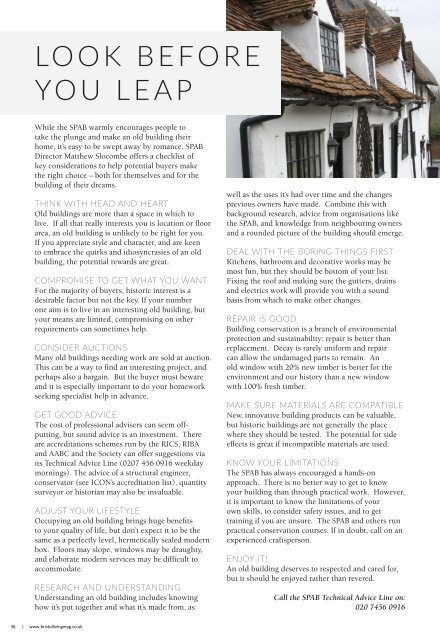Bristol Living Feb - Mar 2020
The Early Spring edition, featuring an interview with top chef Mitch Tonks, fabulous home inspiration, delicious recipes, travel to Santa Barbara and Victorian home renovations.
The Early Spring edition, featuring an interview with top chef Mitch Tonks, fabulous home inspiration, delicious recipes, travel to Santa Barbara and Victorian home renovations.
You also want an ePaper? Increase the reach of your titles
YUMPU automatically turns print PDFs into web optimized ePapers that Google loves.
LOOK BEFORE<br />
YOU LEAP<br />
While the SPAB warmly encourages people to<br />
take the plunge and make an old building their<br />
home, it’s easy to be swept away by romance. SPAB<br />
Director Matthew Slocombe offers a checklist of<br />
key considerations to help potential buyers make<br />
the right choice – both for themselves and for the<br />
building of their dreams.<br />
THINK WITH HEAD AND HEART<br />
Old buildings are more than a space in which to<br />
live. If all that really interests you is location or floor<br />
area, an old building is unlikely to be right for you.<br />
If you appreciate style and character, and are keen<br />
to embrace the quirks and idiosyncrasies of an old<br />
building, the potential rewards are great.<br />
COMPROMISE TO GET WHAT YOU WANT<br />
For the majority of buyers, historic interest is a<br />
desirable factor but not the key. If your number<br />
one aim is to live in an interesting old building, but<br />
your means are limited, compromising on other<br />
requirements can sometimes help.<br />
CONSIDER AUCTIONS<br />
Many old buildings needing work are sold at auction.<br />
This can be a way to find an interesting project, and<br />
perhaps also a bargain. But the buyer must beware<br />
and it is especially important to do your homework<br />
seeking specialist help in advance.<br />
GET GOOD ADVICE<br />
The cost of professional advisers can seem offputting,<br />
but sound advice is an investment. There<br />
are accreditations schemes run by the RICS, RIBA<br />
and AABC and the Society can offer suggestions via<br />
its Technical Advice Line (0207 456 0916 weekday<br />
mornings). The advice of a structural engineer,<br />
conservator (see ICON’s accreditation list), quantity<br />
surveyor or historian may also be invaluable.<br />
ADJUST YOUR LIFESTYLE<br />
Occupying an old building brings huge benefits<br />
to your quality of life, but don’t expect it to be the<br />
same as a perfectly level, hermetically sealed modern<br />
box. Floors may slope, windows may be draughty,<br />
and elaborate modern services may be difficult to<br />
accommodate.<br />
RESEARCH AND UNDERSTANDING<br />
Understanding an old building includes knowing<br />
how it’s put together and what it’s made from, as<br />
well as the uses it’s had over time and the changes<br />
previous owners have made. Combine this with<br />
background research, advice from organisations like<br />
the SPAB, and knowledge from neighbouring owners<br />
and a rounded picture of the building should emerge.<br />
DEAL WITH THE BORING THINGS FIRST<br />
Kitchens, bathroom and decorative works may be<br />
most fun, but they should be bottom of your list.<br />
Fixing the roof and making sure the gutters, drains<br />
and electrics work will provide you with a sound<br />
basis from which to make other changes.<br />
REPAIR IS GOOD<br />
Building conservation is a branch of environmental<br />
protection and sustainability: repair is better than<br />
replacement. Decay is rarely uniform and repair<br />
can allow the undamaged parts to remain. An<br />
old window with 20% new timber is better for the<br />
environment and our history than a new window<br />
with 100% fresh timber.<br />
MAKE SURE MATERIALS ARE COMPATIBLE<br />
New, innovative building products can be valuable,<br />
but historic buildings are not generally the place<br />
where they should be tested. The potential for side<br />
effects is great if incompatible materials are used.<br />
KNOW YOUR LIMITATIONS<br />
The SPAB has always encouraged a hands-on<br />
approach. There is no better way to get to know<br />
your building than through practical work. However,<br />
it is important to know the limitations of your<br />
own skills, to consider safety issues, and to get<br />
training if you are unsure. The SPAB and others run<br />
practical conservation courses. If in doubt, call on an<br />
experienced craftsperson.<br />
ENJOY IT!<br />
An old building deserves to respected and cared for,<br />
but it should be enjoyed rather than revered.<br />
Call the SPAB Technical Advice Line on:<br />
020 7456 0916<br />
36 | www.bristollivingmag.co.uk


















